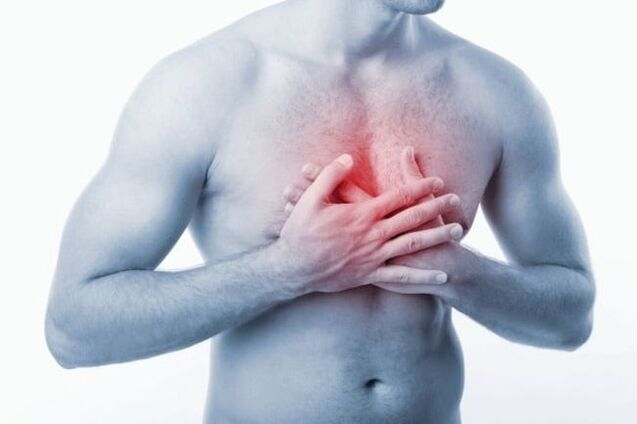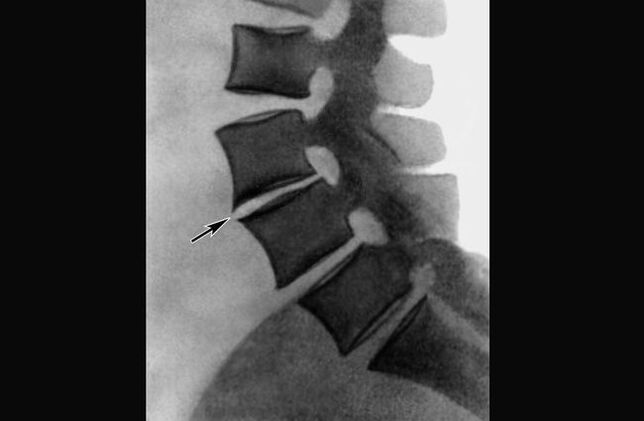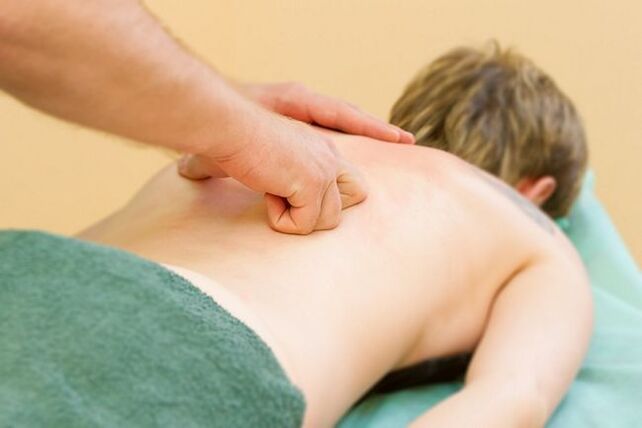Osteochondrosis is one of the most common diseases of the spine. It usually occurs in many people over the age of 40, but it also occurs frequently in younger people. Osteochondrosis is included in ICD-10 with code M42 (codes M40-M43 - deformed back disease)
Osteochondrosis is the layering of the discs so they become flatter and reduce the overall height of the spine. Deformed discs can cause nerve compression and pain. Osteochondrosis in the thoracic region is relatively rare, as this region consists of 12 vertebrae well anchored by the ribs and sternum. The disease usually affects the upper vertebrae in this sector.
Causes of thoracic osteochondrosis
The disorder most commonly occurs in people with frequent familial cases of osteochondrosis, but there are exceptions. The presence of the disease can lead to:
- Congenital diseases of the spine;
- trauma;
- sustained intense physical activity;
- severe metabolic disorders;
- general muscle weakness;
- Infections and frequent temperature changes;
- constant pressure.
Many women develop osteochondrosis during menopause.
Signs of thoracic osteochondrosis
Symptoms of this disease can vary, largely depending on the patient's age, and the extent and stage of the disease. During remission, the disease is barely felt, but during exacerbations, it is impossible not to notice it.

Pathological changes in the spine are manifested by the following symptoms:
- severe or painful pain in the chest in the area of the spine (dorsal);
- Shooting pain, paresthesia, and various sensory disturbances if the nerve roots that come out of the spinal cord are damaged (radiculopathy);
- Soreness in the heart area that does not go away after taking glycerol trinitrate;
- Pulmonary syndrome, which can be identified by signs of hypoxia and poor ventilation;
- acute pain in the abdomen;
- Pain in thoracic osteochondrosis is not accompanied by fever, as is often the case with back pain;
- Pain syndrome that increases with vertebral pressure;
- May develop compressive myelopathy. Myelopathy is characterized by changes in the sensitivity of the skin and muscles near the affected area of the spine.
important!Thoracic and lumbar osteochondrosis often mimics disease of the internal organs. Patients may experience stomach, liver, and heart pain due to nerve compression. Over time, "perceived" disease may actually emerge due to persistent inflammation.
If the patient experiences visceral pain, but pain is the only symptom, it is necessary to check the condition of the spine. So, for example, the tenth vertebra is responsible for the innervation of the kidneys and the general condition of the body. People with osteochondrosis experience kidney pain and feel tired quickly. That's why it's important not to self-medicate, as various forums often suggest, but to consult a specialist.

Staging of thoracic osteochondrosis
The International Classification divides thoracic osteochondrosis into 4 stages (degrees), each with its own clinical presentation:
1 degree.At this stage, the disease simply occurs as the discs lose water, lose their height, and the vertebrae move closer to each other and begin to compress the nerves. Patients may experience a localized pain syndrome in the affected vertebral region, with occasional characteristic back pain. Active exercise and physical exertion can create pain, but some exercise can relieve discomfort. Usually, level 1 is for general fatigue, so people should not rush to seek medical attention.
2 degrees.The vertebrae lose their stability and cracks form in the annulus fibrosus. Due to the increased instability, both obvious and hidden subluxations are possible, which can cause a lot of trouble in the future. Patients experience pain not only during physical exertion, but sometimes also at rest (eg, on the side or on the back). Grade 2 osteochondrosis is also characterized by general weakness, increased fatigue, and pain can be observed in the visceral areas of the extremities. Chest pain may occur.
3 degrees.The annulus fibrosus thins and ruptures, leading to a herniated disc. The disease causes many deviations in the work of the internal organs, as the spine is in a curved state and severely restricts movement, forcing a person to adopt positions that feel less painful. The pain syndrome is very intense and at this stage it is possible to form a spine with radiculopathy.
4 degrees.The vertebrae begin to widen, their protrusions ossify, as do the remnants of the intervertebral disc. Patients often notice a reduction in pain, but also a significant decrease in mobility of the spine. The vertebrae come close to each other, ossify and grow their roots, which reduces the spine's ability to depreciate. A person with advanced osteochondrosis loses significantly in height, his movements become restricted, and a curvature of the spine (kyphosis or lordosis) is observed.
In the context of osteochondrosis of the thoracic spine, various diseases that can form viscera, delays in diagnosis and treatment are dangerous.
diagnosis method
The main radiological signs of this disease are:
- Irregular contour of the intervertebral disc;
- the wavy edge of the outer skin;
- The hook-like protrusions become larger and sharper;
- reduced disc height;
- changes the shape of the intervertebral disc;
- Herniated disc (easier to identify anterior hernia);
- the occurrence of osteophytes;
- The shape of the vertebral bodies has changed.
In some cases, a contrast X-ray study - a discography is done, which shows the following features:
- Irregular outline of nucleus pulposus;
- In severe stages of the disease, the intervertebral disc is completely filled with contrast medium;
- With significant destruction of the disc, the observed contrast exceeds its limits and sometimes falls into the spinal canal.
Consequences of osteochondrosis
If left untreated, the disease progresses very rapidly. But with successful treatment, the number of complications that can arise is low. There are several major complications of osteochondrosis:
- sciatica
- Spondylopathy of the thoracic spine (and other disciplines)
- Frequency
- hearing or vision loss
- radiculitis
- Migraine
- low back pain
- intervertebral reddish brown
- Spondyloarthropathy
- Disability
- chest pain
- epicondylitis
Main treatments for thoracic osteochondrosis
Treatment of thoracic osteochondrosis is now performed using the following methods:
- Conservative treatment
- operation treatment
- traction

Medicine is based on several principles. The main thing is to fight pain, as well as reduce inflammation. Therefore, doctors use anti-inflammatory drugs to eliminate pain.
To improve the condition of cartilage, doctors prescribe chondroprotective agents to patients.
Often, limitations in spinal movement are caused by highly stretched muscles. To get rid of the disease, doctors prescribe muscle relaxants and antispasmodics.
To reduce pain, doctors recommend that patients use various ointments for osteochondrosis, which have a warming effect.
In order to effectively treat this disease, it is important for doctors to control the dosage of the drug. The patient must remember that the medication must be taken exactly in the order in which the doctor instructs it. Do not mix medications or substitute analogs for medications without the consent of the attending physician.
In addition to medical treatment, doctors may also prescribe acupuncture, reflexology, physical therapy, and therapeutic massage. All of these treatments should be discussed in detail with your doctor and must be performed by a professional.
In the early stages of the disease, the entire treatment process for thoracic osteochondrosis is limited to physiotherapy exercises and some special exercises for osteochondrosis. Drug therapy includes prescribing metabolism-improving drugs as well as vitamin therapy.
Advise patients not to perform gymnastics without first discussing it with their doctor. It should be noted that gymnastics cannot be performed in the acute phase of the disease. Choose any exercise therapy based on the location of the damaged area of the spine. Folk remedies can also be used.
What should I do if my condition worsens?
The worsening of osteochondrosis is always accompanied by pain. Therefore, the main treatment is aimed at reducing pain.
For this purpose, non-steroidal anti-inflammatory drugs are prescribed. They reduce the production of prostaglandins, which stimulate nerve endings that cause pain. In cases where these drugs are ineffective, local anesthetics can be used to block. In addition, strenuous exercise should be avoided and rest is recommended during the exacerbation of the disease. Therefore, in this case, thoracic vertebral osteochondrosis exercise is prohibited until further decision by the attending physician.

Precaution
To prevent the development of thoracic osteochondrosis, you should always take care of your health.
The first step is to eliminate all factors that may trigger the formation of osteochondrosis, not forgetting the dangers of heavy physical exertion, maintaining correct posture.
Everyone should get regular checkups at a specialized pharmacy. If during the physical examination, the doctor discovers a primary lesion of the spine, the patient should contact the orthopaedic doctor immediately.
To prevent disease, all diseases must be treated in a timely manner, which is especially important in diseases of the musculoskeletal system. After an injury, mandatory rehabilitation is necessary.

Take care of your body: Change your body position at work, avoid hypothermia and overheating, and don't forget to check up.
At home, people can't always keep their body in the right tone as they can at the gym. However, don't forget to strengthen your back muscles with a variety of exercises. So, for example, physical therapy exercises for osteochondrosis can be helpful. The most important thing is not to overdo it. And photos and videos of exercises are easy to find on the internet.
The best way to prevent any disease is to eat a balanced diet. Your diet should include not only vegetables, but also a variety of vitamins, which is especially important during spring and winter. To strengthen the back, massage, medication, swimming can be used.

























